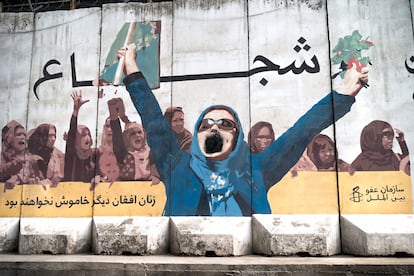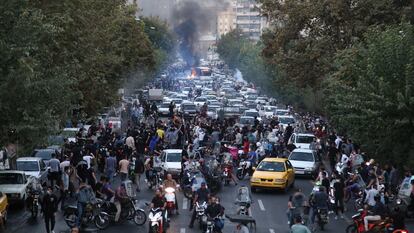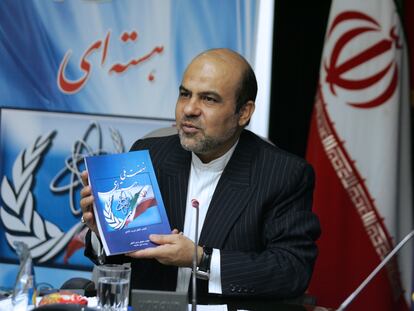The struggle of Iranian women lights the way for Afghans: ‘Iran has risen up, now it is our turn’
Small-scale demonstrations in Kabul find inspiration in the widespread protests against the religious regime of their neighboring country


“Iqra” (“read” in Arabic) was the first word that Allah revealed to the Prophet Muhammad, Muslims believe. Those four letters adorned a sign that an 18-year-old Afghan woman held up for an interminable quarter of an hour in front of heavily armed Taliban on December 25 outside the gates of Kabul University. Five days earlier, the fundamentalist government had banned Afghan women from higher education. With this solitary act of defiance that was reported by the BBC, the young woman was criticizing authorities for having trampled on the duty of attaining knowledge that the Koran imposes on all Muslims.
In the 17 months since the return of the Taliban to power, small protests such as this one have made Afghan women the most visible face of resistance against the extremists who are depriving them of their rights in the name of religion. The same argument is being used by the regime in neighboring Iran to subjugate its own women, albeit less radically. Iranian and Afghan women share “the same goal,” says former Afghan MP Zakia Noori. That goal is “to achieve freedom.”
Afghan women have raised their voices in support of the protests in Iran since their inception. On September 20, four days after the death in police custody of young Mahsa Amini – the trigger for the demonstrations against the Ayatollahs’ regime – a statement from the organization Women Protesters of Afghanistan adopted the slogan “Woman, Life, Freedom,” chanted precisely in the Iranian streets. “We cry out this common pain. The Taliban in Afghanistan and the dictatorial government of Iran cannot stifle the voice of free women,” the text continued. Nine days later, around 25 Afghan women demonstrated with photos of Amini in front of the Iranian Embassy in Kabul while chanting that slogan and others such as “Iran has risen, now it is our turn,” before being dispersed by the Taliban, as seen in images posted on social media.
Afghan women despite being under immense pressure and Deprived of their all human and basic rights themselves decided to protest In Solidarity and support of Women of Iran, in front of Iranian Embassy in Kabul.#Mahsa_Amini #OpIran
— Nilofar Ayoubi 🇦🇫 (@NilofarAyoubi) September 29, 2022
pic.twitter.com/XkfXLayDRE
Solidarity also works in reverse. In October, the Iranian graffiti collective Khiaban Tribune posted a message of support for Afghan women with the phrase: “We are both fighting... against a Taliban.” Well-known Iranian activists, such as Masih Alinejad, have compared the Taliban to the Iranian regime on social media and expressed their fears about the fate that awaits Afghan women. An analysis by the United States Institute of Peace (USIP) think tank finds that “it is only natural that two communities tied by language [Persian], culture and their oppression by authoritarianism masquerading as religious faith, are finding synergies.”
Today in Iran.
— Masih Alinejad 🏳️ (@AlinejadMasih) October 13, 2021
Soon enough Taliban would do the same again to the women of Afghanistan.
Taliban And Islamic Republic will never be really reformed.#MyCameraIsMyWeapon pic.twitter.com/VdqxnJZTir
The Taliban and the Iranian regime share a common nature as autocracies that invoke religion, although the former profess Sunni Islam, the majority branch, while the latter embrace Shia Islam. They also share the opprobrium of the West – more pronounced in the case of Afghanistan – but, above all, what they have in common is repression of women as one of their main pillars, together with their disastrous record of human rights violations and cruelty shown by punishments such as stoning, amputation and flogging, or the hanging of dissidents from a crane.
In other aspects, the distance between the two countries is enormous, and so is the condition of women. Iran has a population of 87 million, while Afghanistan has 40 million, according to World Bank data. Figures provided by the United Nations show that 85.5% of Iranian women over the age of 15 can read and write, and 60% of university students are women. In Afghanistan, in 2020, only 29.8% of women could read and write. Iran is a country with a civilization stretching back thousands of years, where 76% of the population lives in the cities, according to the World Bank. Its Afghan neighbor remains a rural country, with only 26% of its population living in urban centers.
“Despite its religious and conservative character, the Islamic Republic [of Iran] is a modernizing regime. In 1979, 50% of the Iranian population was illiterate and 60% of the illiterate were women. Today, Iran’s literacy rate is 90% and, just as surprisingly, 60% of university students are women,” political scientist Ali Alfoneh stresses by email from the United States. This regime “on the one hand, wants to control women and, on the other hand, provides them with higher education, two contradictory things. The Iranian authorities do not understand that, for example, you cannot dictate to university women how they should dress [referring to the veil]. In Afghanistan, the Taliban know what they want: to control women. That’s why they prohibit them from accessing education.”
Some Iranian women have forced the hand of religious leaders in their country, even after death. When Iranian mathematician Maryam Mirzakhani died in 2017 at age 40 of breast cancer, senior officials in her country were forced to publish photos of her without a veil. Mirzakhani, a resident of the US, never wore one. The first woman to win the Fields Medal, the Nobel Prize for mathematics, was too prestigious to hide her image.
All alone
“If Iranian women are not like Afghan women, it is because we have not allowed it. Neither we nor our men,” says Nilufar Saberi, an Iranian activist in Spain. She is speaking about the massive presence of men in the demonstrations in which, in the last four months, at least 481 people have died as a result of repression. More than 18,000 have been arrested and at least four executed, according to the NGO Iran Human Rights.
Former MP Zakia Noori was responsible for ensuring the gender perspective of the Afghan budget before the Taliban returned to power. Noori believes that “both Iranian and Afghan women are victims of the religious government in their countries,” but “on different scales, because in Afghanistan women are not even allowed to go to school, university, work or travel.”
By email from Pakistan, the former lawmaker describes the “loneliness” of the protesters: “A large number of Afghans still hold reactionary religious views about women. In most regions, and even in some big cities, it is often the families who do not allow young girls to go to school.” Despite this, in the 20 years of the international presence in Afghanistan (2001-2021), “Afghan women have made enormous progress in terms of the right to education and work, have increased their collective self-confidence and have become aware of the struggle for their rights and freedom, which is alien to our history,” Noori stresses.
The minority of educated Afghan women have made “enormous progress,” agrees Shahlla Arifi, former head of Afghanistan’s now-defunct Women’s Ministry. These young women, who had not experienced “the abuses of the Taliban in their previous government [1996-2001], are ready to fight to the end for their rights,” says Arifi. Their struggle goes on, adds Noori, “empty-handed, alone and helpless, and without international support in the face of the most brutal regime in the world.”
Sign up for our weekly newsletter to get more English-language news coverage from EL PAÍS USA Edition
Tu suscripción se está usando en otro dispositivo
¿Quieres añadir otro usuario a tu suscripción?
Si continúas leyendo en este dispositivo, no se podrá leer en el otro.
FlechaTu suscripción se está usando en otro dispositivo y solo puedes acceder a EL PAÍS desde un dispositivo a la vez.
Si quieres compartir tu cuenta, cambia tu suscripción a la modalidad Premium, así podrás añadir otro usuario. Cada uno accederá con su propia cuenta de email, lo que os permitirá personalizar vuestra experiencia en EL PAÍS.
¿Tienes una suscripción de empresa? Accede aquí para contratar más cuentas.
En el caso de no saber quién está usando tu cuenta, te recomendamos cambiar tu contraseña aquí.
Si decides continuar compartiendo tu cuenta, este mensaje se mostrará en tu dispositivo y en el de la otra persona que está usando tu cuenta de forma indefinida, afectando a tu experiencia de lectura. Puedes consultar aquí los términos y condiciones de la suscripción digital.
More information
Archived In
Últimas noticias
Alain Aspect, Nobel laureate in physics: ‘Einstein was so smart that he would have had to recognize quantum entanglement’
Imelda Castro, the woman who wants to rule the cartel battleground of Sinaloa
The new victims of the Republican war on Obamacare: Millions hit by soaring health insurance premiums
A country divided on migrant rights: Some US states expand protections while others restrict them
Most viewed
- David King, chemist: ‘There are scientists studying how to cool the planet; nobody should stop these experiments from happening’
- Reinhard Genzel, Nobel laureate in physics: ‘One-minute videos will never give you the truth’
- Oona Chaplin: ‘I told James Cameron that I was living in a treehouse and starting a permaculture project with a friend’
- Sinaloa Cartel war is taking its toll on Los Chapitos
- Mexico completes its trade shift with the entry into force of tariffs on China and countries without trade agreements











































